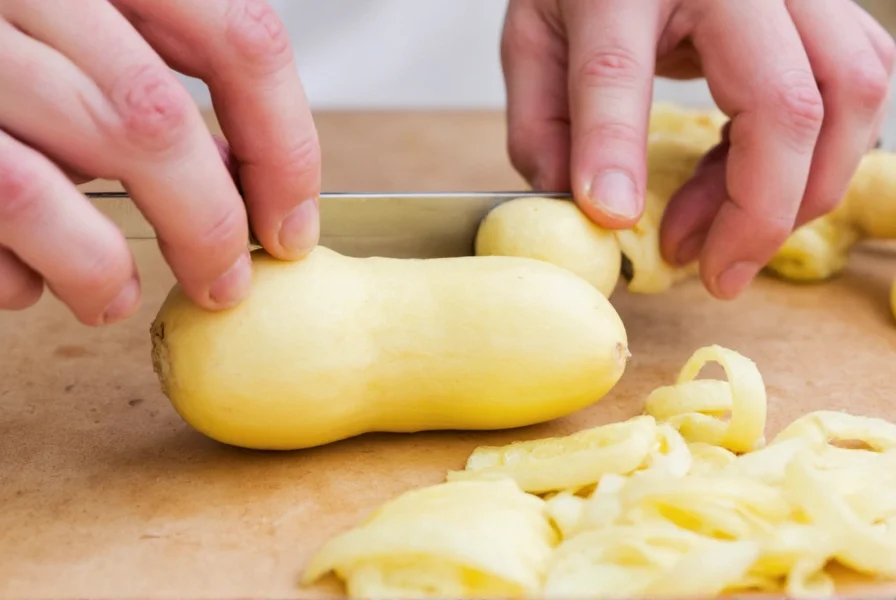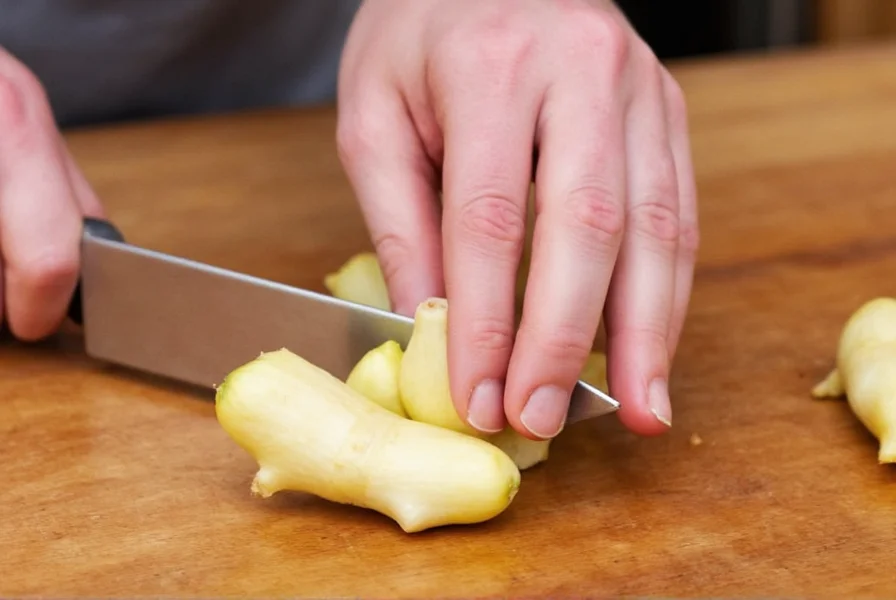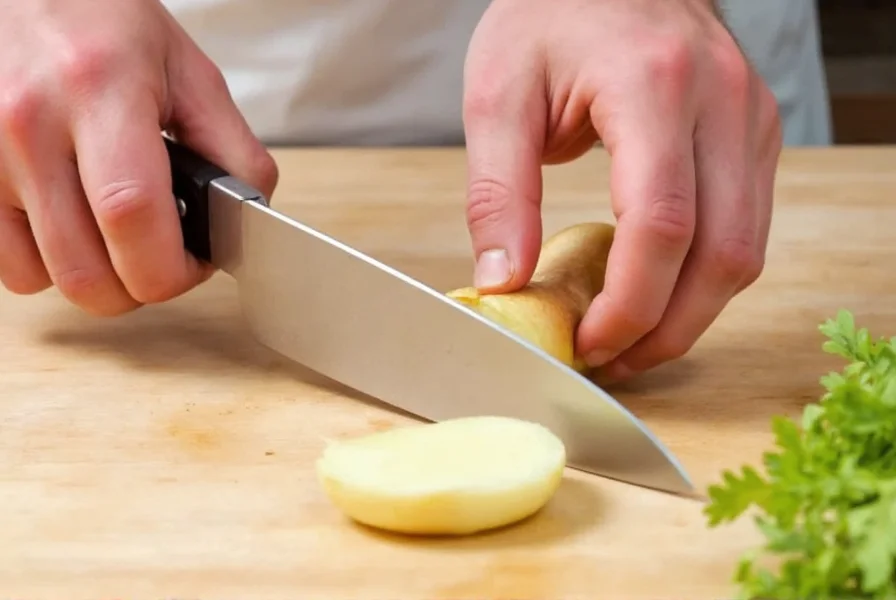Cutting ginger properly transforms this knobby root from a kitchen challenge into a culinary asset. Many home cooks struggle with ginger's fibrous texture and irregular shape, leading to wasted product or uneven flavor distribution in recipes. Understanding the proper technique for preparing ginger root makes a significant difference in both efficiency and final dish quality.
Essential Tools for Cutting Ginger Root
Before learning how to cut ginger root effectively, gather these kitchen essentials:
| Tool | Best For | Alternative |
|---|---|---|
| Chef's knife (6-8 inch) | Slicing and mincing larger quantities | Utility knife |
| Vegetable peeler | Smooth-skinned ginger | Spoon (best for wrinkled ginger) |
| Ceramic mortar and pestle | Crushing ginger for maximum flavor release | Side of chef's knife |
| Microplane grater | Finely grating ginger without fibers | Box grater |
Professional chefs consistently recommend using a spoon rather than a peeler for how to peel and cut fresh ginger, especially with older, more wrinkled roots. The spoon's edge follows ginger's contours perfectly, removing minimal flesh while eliminating all papery skin.
Step-by-Step Guide: How to Cut Ginger Root Properly

Peeling Ginger: The Spoon Method
1. Select firm ginger with tight skin and no soft spots
2. Hold ginger firmly on cutting board
3. Use edge of spoon to scrape away skin in downward motions
4. Work around all contours until completely peeled
5. Rinse briefly under cold water to remove any remaining fibers
This technique for how to cut ginger root properly removes only the necessary amount of flesh, preserving up to 30% more usable ginger compared to traditional peelers. The spoon method works particularly well for the proper technique for mincing ginger later in the process.
Slicing Ginger for Different Applications
After peeling, position your knife perpendicular to ginger's fiber direction (visible as parallel lines running through the root):
- For stir-fries: Cut 1/8-inch slices against the grain, then stack and julienne
- For teas and infusions: Cut 1/4-inch thick coins (maximizes surface area)
- For baking: Finely mince or use microplane for smooth texture
- For sushi: Cut extremely thin slices using a sharp knife and steady hand
Always cut across the grain rather than with it—this breaks up tough fibers, creating more tender pieces that distribute flavor evenly. This critical detail separates novice attempts from professional results when learning how to cut ginger root effectively.
Advanced Techniques for Maximum Flavor
For recipes where ginger flavor is central, employ these professional chef methods:
- Crush before chopping: After slicing, place flat side of knife on ginger and press down firmly to rupture cell walls
- Dry brine technique: Sprinkle sliced ginger with salt and let sit 10 minutes to draw out moisture and concentrate flavor
- Cold infusion: For delicate dishes, steep sliced ginger in cold liquid rather than boiling to preserve nuanced flavors
Understanding how to cut ginger root for specific cooking methods prevents the common mistake of overpowering dishes with ginger's sharper compounds while missing its subtler aromatic notes.
Storage Methods for Cut Ginger
Properly stored cut ginger maintains freshness significantly longer:
- Refrigerator: Store in airtight container with damp paper towel for up to 3 weeks
- Freezer: Freeze whole peeled ginger or pre-cut portions in freezer bags for 6+ months (no need to thaw before use)
- Vinegar method: Submerge in rice vinegar in glass jar for flavored ginger with 1-month shelf life

Freezing whole ginger actually makes the how to cut ginger root process easier—the frozen state firms up the fibers, allowing for cleaner slices. Simply remove what you need and return the rest to the freezer immediately.
Common Mistakes to Avoid
Even experienced cooks make these errors when preparing ginger:
- Peeling too deeply: Using a vegetable peeler removes too much usable flesh
- Cutting with the grain: Creates stringy, tough pieces that don't distribute flavor well
- Over-mincing: Releases too many volatile compounds, creating bitter notes
- Adding too early: In cooked dishes, add ginger at appropriate stage based on desired flavor intensity
Mastering the proper technique for mincing ginger ensures optimal flavor release without bitterness. The best knife for cutting ginger root should be sharp but not serrated—serrated edges crush rather than slice the delicate fibers.
Practical Applications in Cooking
Different cutting techniques serve specific culinary purposes:
- Thin slices: Ideal for tea infusions and braises where gradual flavor release is desired
- Fine mince: Best for marinades and dressings requiring even distribution
- Julienne: Perfect for stir-fries where visual appeal matters
- Grated: Works well in baked goods and smooth sauces where texture should be undetectable
When following recipes that specify "fresh ginger," understanding how to cut ginger root properly ensures you achieve the intended flavor profile. The size and shape of your ginger pieces directly impacts how quickly and completely flavors infuse into your dish.
What's the easiest way to peel ginger without wasting flesh?
The spoon method is the most efficient technique for peeling ginger. Simply use the edge of a spoon to scrape away the skin in downward motions. This follows ginger's natural contours, removing only the papery skin while preserving up to 30% more usable flesh compared to traditional peelers. It works especially well on older, more wrinkled ginger roots where the skin has become papery.
Should I cut ginger with or against the grain?
Always cut ginger against the grain (perpendicular to the visible fiber lines running through the root). Cutting against the grain breaks up the tough fibers, creating more tender pieces that distribute flavor evenly throughout your dish. Cutting with the grain produces stringy, tough pieces that don't release flavor properly and create unpleasant texture in finished dishes.
How can I prevent my fingers from smelling like ginger after cutting?
To prevent ginger odor on your hands, rub them with lemon juice or vinegar immediately after handling ginger, then wash with soap and water. Alternatively, wear thin food-safe gloves while preparing ginger. Stainless steel soap bars rubbed under running water also effectively neutralize the compounds that cause persistent ginger smell on skin.
Can I freeze ginger before cutting it?
Yes, freezing ginger for 15-20 minutes makes it firmer and easier to slice cleanly. For long-term storage, freeze whole peeled ginger in freezer bags—you can grate it directly from frozen without thawing. The frozen state actually makes the how to cut ginger root process easier by firming up the fibers for cleaner cuts, and frozen ginger lasts 6+ months in the freezer.
What's the difference between mincing and grating ginger?
Mincing creates small, distinct pieces that provide texture and bursts of flavor, while grating produces a pulp that distributes flavor more evenly throughout a dish. Mincing works better for stir-fries and dishes where ginger texture is desirable, while grating is ideal for marinades, dressings, and baked goods where you want ginger flavor without noticeable pieces. Microplaning yields the finest texture without fibrous strands.











 浙公网安备
33010002000092号
浙公网安备
33010002000092号 浙B2-20120091-4
浙B2-20120091-4